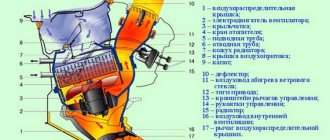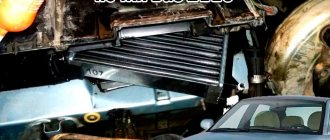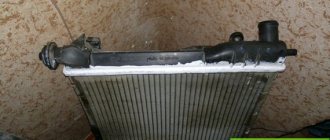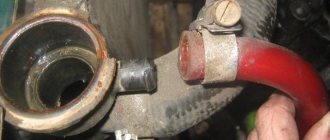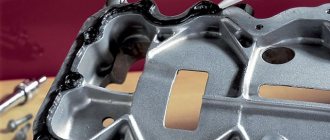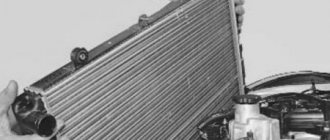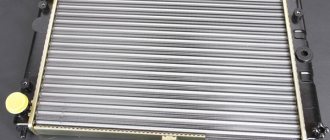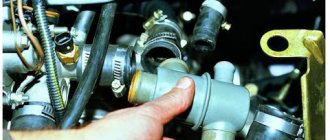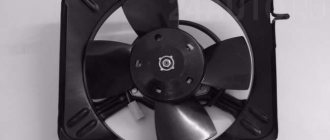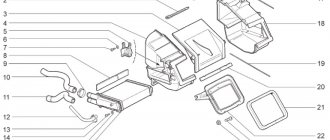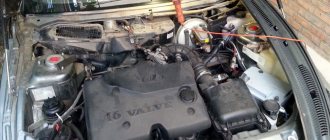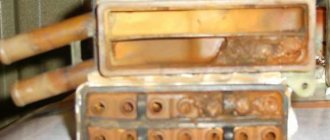While changing the oil, I discovered that the main cooling radiator was sweating (the right side is the junction of aluminum and plastic), changing it is not an option yet, I decided to try this remedy
I filled half the bottle, drove it for a week, and today I examined it and it seems like everything is fine. I'll drive around a little and we'll see.
description from the manufacturer's website www.bbf.spb.ru/cat/222/screen1/ru To eliminate minor leaks of coolant from the radiator and other elements of the internal combustion engine cooling system. Does not clog radiator tubes, hardens only in leak areas. Withstands high temperatures and prevents future leaks. Compatible with all types of coolants.
intended only for the engine for occasional use does not harm adjacent parts and surfaces provides additional protection
Car radiator sealant allows you to get rid of leaks in the engine or heater cooling system. With its help, you can eliminate a small leak in “field conditions” when the car owner does not have the opportunity to carry out a full repair with the replacement of individual elements of the corresponding cooling and heating systems.
When choosing a good radiator sealant, you need to consider the following aspects:
- its type (there are powder, liquid and polymer);
- scope and restrictions on use;
- the time between pouring sealant into the system and eliminating the leak;
- the relationship between price, quality, volume of product in packaging;
- reviews from car owners about certain antifreeze sealants, both positive and negative.
Below will be a rating of the most popular products, based on reviews and tests of various radiator sealants. If you have personal experience using liquid or powder radiator sealant, we would be glad to hear your opinion on this matter in the comments.
| Diameter of the "tightened" hole | BBF Super | Liqui Moly | K-Seal | Hi-Gear | Gunk | Fill Inn |
| Time for complete closure of calibrated holes, sec | ||||||
| 0.3 mm | 20 | 30 | 75 | 35 | 154 | 126 |
| 0.5 mm | 85 | 62 | 115 | 96 | 224 | 612 |
| 0.7 mm | 124 | 88 | 315 | 345 | 245 | 292 |
| 1.0 mm | 146 | 118 | 380 | 630 | 218 | n/a |
Types and application of sealants in radiators
Before moving on to the description of the various types of sealants used in 2019 for car radiators, it is necessary to mention that repairing radiators with sealant can only be carried out as a temporary measure to eliminate leaks in conditions where the car owner does not have the opportunity to carry out a full repair with the replacement of individual components . The reason for this is that the sealant (regardless of its type) significantly clogs the system, thereby not only reducing its efficiency, but also reducing the service life of individual elements. In this regard, many car enthusiasts simply refuse to use it in favor of full mechanical repairs to eliminate leaks in the system.
What type of sealants for the cooling system is better?
Now let's move on to describing the types of radiator sealants themselves. Yes, they are:
- Powder . These are the simplest products that are poured dry into the cooling or heating system. In addition to factory-made products, domestic car enthusiasts use powdered table mustard and even dry tobacco for this purpose. Using radiator sealant in powder form, you can eliminate leaks caused by small damage, in particular up to 1 mm. The undeniable advantage of powder sealants is their low cost, and a significant disadvantage is significant clogging of the system, not only at the site of damage, but throughout its entire length.
- Liquid . These are complex preparations that contain polymers with the addition of metal particles. They can be used not only to eliminate leaks in radiators, but also in the engine cylinder head. The advantage of polymer compounds is that they work “softly”, clinging to the roughness of damage and, as it were, enveloping them. The advantage of such sealants is the fact that they are constantly in the antifreeze, and when it is replaced, they are completely removed from the cooling system. However, their disadvantage is the ability to seal only small holes up to 1 mm in size.
- Polymer . These are modern and the best radiator sealants available today. They are also based on a polymer composition using metal particles, but their significant difference is that they can be used to seal larger cracks, in particular, up to 2 mm or more.
Many car owners doubt the effectiveness of their compounds and wonder: does radiator sealant help? In general, we can say that yes, it helps, but this depends on its type, size and location of the damage (leak), as well as the method of using the product. Usually, each sealant comes with instructions for its use. However, in most cases, the use of sealants is identical, despite their varieties.
Remember that an indirect sign of an antifreeze leak is constant overheating of the engine, which will be indicated to you by the indicator on the dashboard. And puddles under the car, or at least antifreeze leaks on elements of the engine compartment.
Precautionary measures
When repairing radiators or other parts of the cooling system, be sure to adhere to the following safety measures and proper use of the composition:
- The room where car repairs are carried out must be well ventilated or have a ventilation system.
- Do not inhale the vapors of the product, otherwise it is harmful to health.
- Work in PPE, as the mixture should not come into contact with the skin and mucous membranes of the eyes.
If there is a spill on the skin or the product gets into the eyes, immediately rinse the affected areas under running warm water. Consult a doctor.
- After work, wash your hands thoroughly.
- The sealant is stored out of the reach of children.
- Until the crack is completely sealed, do not expose it to mechanical or chemical stress.
- Contact of the sealant with used materials that have oily leaks, bitumen, etc. is unacceptable; when interacting with them, a change or non-compliance with the tone of the composition is provoked.
How to pour sealant into a radiator
An approximate algorithm for using sealants in the cooling system would be as follows:
- It is necessary to open the radiator cap only with the engine turned off and slightly cooled!
- Pour or pour (depending on the type of sealant) into the radiator the amount of compound specified in the instructions.
- Start the engine and let it run for a few minutes, then turn it off.
- After some time, check for leaks with the engine running.
Application
All products have similar instructions for use:
- The engine must be turned off and completely cool.
- Before use, shake the bottle of liquid well and pour it into the radiator, first removing the cap. If there is no cap, you can fill the liquid through the upper nozzle by first disconnecting the hose. Many liquids can be poured into the expansion tank by first draining 2-3 liters of cooling liquid. But this method is not suitable for HG9048, HG9072 sealants.
- Fill with antifreeze or antifreeze to the required level.
- If the design includes a heater tap, it must be opened.
- Start the car and warm it up for about 7 minutes at idle speed (2000 to 3000 rpm).
- Stop the engine and let the engine cool down.
- Refill with antifreeze or antifreeze until normal.
The instructions for a sealant that is used only with water will be slightly different:
- The engine must be turned off and completely cool.
- If the design includes a heater tap, it must be opened.
- The existing coolant must be completely drained.
- Flush the entire cooling system with water twice. Each flush is accompanied by warming up the engine. If the system is heavily contaminated, it is recommended to first flush it with a special flush for the cooling system.
- Take 2.5 liters of water and mix with the contents of the bottle. The resulting solution is poured into the system, water is added to the norm.
- Warm up the engine at idle speed at medium speed for about 20 minutes. After the time has elapsed, the leak should stop. If this does not happen, wait a few more minutes.
- Then the engine is completely cooled and all the water is drained.
- The cooling system needs to dry out for at least 3 hours, leaving it completely open. For complete drying, it is better to leave it to dry for a day.
- After this, fill in antifreeze or antifreeze.
The best radiator sealant
The choice of radiator sealant by car owners is always accompanied by the same question - which one is better? Based on tests carried out by specialists from the authoritative publication “Behind the Wheel” and comparisons of the results of using certain products, a rating of the most popular and effective sealants was compiled.
For the experiment, a tube with four holes with diameters of 0.3 mm, 0.5 mm, 0.7 mm and 1.0 mm was cut into the pipeline between the radiator and the thermostat of the car. Below is a table indicating the results obtained, in particular, the time it takes each of the tested products to “tighten” the holes.
Radiator sealant rating
BBF Super
This sealant came in first place due to the fact that it quickly and reliably seals cracks in the elements of the cooling system. So, in order to “tighten” a hole with a diameter of 0.3 mm, it took him only 20 seconds, while the other presented sealants took much longer. According to the description, it forms a durable polymer plug that reliably holds antifreeze in the system. The sealant is safe for steel, cast iron, plastic, aluminum, rubber parts and non-ferrous alloys.
The method of using sealant is classic. To do this, turn off and let the engine cool (at least to medium temperature). After this, open the radiator cap, shake the bottle and add the composition into the radiator. You can also add sealant to the expansion tank of the cooling system. If the car has a heater tap, then it needs to be opened. After this, you need to start the engine, set its rotation speed to 2000. 3000 rpm, and let it run for 5. 7 minutes.
The bbf radiator additive very quickly seals small holes and copes with relatively large ones without problems. Sealing occurs quite neatly, with virtually no residual deposits.
Radiator sealant “BBF Super” is sold in a small canister with a volume of 325 ml. As of summer 2021, its price is about 80 rubles. Article: BBF5346. The price-quality ratio also speaks in favor of this product.
Liqui Moly Kuhler Dichter
Positioned by the manufacturer as a sealant for the cooling system. Designed to eliminate small cracks in cooling system elements. Protects the engine combustion chamber from antifreeze entering it. The sealant is suitable for use with any coolant. The composition can be used in engines with aluminum radiators, and is also safe for plastic elements. Can be used in cooling systems that require the use of a water filter.
Please note that the use of this sealant differs from other similar compounds! So, the additive must be added to the cooling system of the engine while the heater is on. After the sealant has been added, you need to let the engine run for about 10 minutes at idle speed. Remember that the bottle holds 10 liters of antifreeze, so use it according to the coolant volume of your car.
Cooling system sealant from Liqui Moli can be called a leader in the speed of eliminating holes. Moreover, it copes with relatively large damage. Seals holes securely. According to reviews from car owners, no leaks are observed after its use. In fact, it has 2 drawbacks - residual sediments in the form of multi-colored metal powder, and a high price.
Sold in a 250 ml bottle. Its article number is 1997. The price for the specified period is 350 rubles.
K-Seal
This sealant has average performance characteristics. For example, a hole with a diameter of 0.3 mm is tightened by the product in 75 seconds, and a hole with a diameter of 1 mm - in as much as 6 minutes and 20 seconds. And given its relatively high cost, this sealant can be classified rather as “middle class”. Another feature of it is that this sealant is sold quite rarely on the domestic market, so the decision to purchase it lies entirely with the car owner.
Positioned as a “long-lasting” product. It contains copper powder, which mixed with polymers forms a reliable protective plug. The advantage of this product is the presence of a small amount of deposits in the cooling system after its use. Suitable for mixing with all types of antifreeze, safe for both cooling system elements and the engine. The disadvantage is the high price, one canister costs about 700 rubles.
This radiator leak remedy is recommended to be used if repairing damage to the radiator is not very urgent, but reliably and for a long time. Forms a small level of deposits after application.
Hi-Gear Radiator Stop Leak
The manufacturer positions this sealant as a composition for repairing radiators and cooling systems. Can be used with copper radiators, aluminum heat exchangers of modern composite radiators and other elements of the engine cooling system. Safe for aluminum, steel, cast iron, non-ferrous alloys, plastic, rubber. Can be used with all types of antifreeze, as well as ordinary water. Please note that this sealant can be used even in heavily loaded engines!
The use of sealant is similar to that described above. With the engine turned off and slightly cooled, it is necessary to remove the radiator cap and add the amount of sealant to the antifreeze in accordance with the calculations (see instructions). Next, start the engine and let it run for 5.7 minutes at 2500.3000 rpm. After this, turn off and cool the engine.
Car owners note a high level of residual deposits after using this product. Also, a disadvantage of the sealant is its unstable operation; the occurrence of chemical reactions to “heal” the holes occurs spasmodically, under the influence of external factors. The advantages of the sealant include reliable “healing” of damaged areas of internal combustion engine cooling systems.
The use of sealant for the cooling system from High Gear can be called a game of roulette, since sealing the holes is not very stable. We can say with confidence that it seals small holes quite quickly, but larger ones with varying success (especially in the first minutes after pouring into the radiator). In addition, it has a relatively high level of residual deposits.
Purpose and compatibility
Auto repair composition (HG9025, HG9029) is used to eliminate microcracks in composite or copper radiators. This High-Gear sealant eliminates leaks at solder joints and joints of plastic tanks. It is suitable for eliminating leaks through the thermostat gasket, pumps, pipes, radiator pipes, and faucet seals. Compatible with all types of antifreeze and antifreeze. Suitable for use on steel, aluminum, cast iron parts, as well as parts made of non-ferrous metals, rubber or plastic.
Metal sealants (HG9072, HG9048) quickly eliminate damage to interior heaters, radiators, and engine cylinders. HG9048 is used for SUVs and cars. For construction equipment, trucks, buses, HG9072 is used. Compatible with all types of antifreeze and antifreeze. Suitable for aluminum, composite, copper, plastic radiators.
Metal sealant HG9037 has the difference that it must be added only to water. Adding it to antifreeze is strictly prohibited. Designed for repairing radiators, gaskets, blocks, cylinder heads. After application, any coolant can be used.
Metal-ceramic sealant (HG9043, HG9041) is a professional car repair product that is used to eliminate most damage, including large sections. And thanks to the ceramic fibers in the composition, the product provides additional strength. Compatible with any antifreeze or antifreeze. Used for repairing composite, copper and aluminum radiators.
How to flush a radiator from sealant
As mentioned above, the use of sealant leads to the formation of plaque in the car’s cooling system on the internal surfaces of its components, which interferes with its normal operation. The consequence of this is the need to clean the system from contaminants using special means. There are several types of them, including the so-called folk, homemade and factory-made.
Thus, folk cleaning products include citric acid, acetic acid, the famous Fanta drink, lactic acid, whey, caustic soda. You can also dissolve the radiator sealant using factory-made products, which are currently abundant on the market. Some of the most popular are LAVR Radiator Flush Classic, Hi-Gear Radiator Flush, LIQUI MOLY Kuhler-Reiniger. They effectively clean the radiator and other elements of the cooling and heating system. Please read the operating instructions carefully before using them.
How to flush the engine cooling system?
List of products for cleaning the engine cooling system. What is better to rinse, and what is not worth cleaning the radiator and all components?
Conclusion
Using radiator sealant is a good temporary solution to fix an antifreeze leak, provided the damage is small. However, its constant use leads to significant clogging of not only the cooling system, but also the engine itself. On the Internet you can find many unpleasant stories about how sealants used on a regular basis literally “killed” internal combustion engines. Therefore, whenever possible, after using radiator sealant, perform appropriate diagnostics and repairs.
As for choosing a particular sealant for a radiator, it is better to use proven factory products, for example, those listed above in the rating above. It is undesirable to use folk remedies such as mustard or cigarette tobacco. This will significantly contaminate the cooling system, reducing its efficiency and shortening its service life.
Is it possible to eliminate leaks in the cooling system yourself? And what consequences can you expect?
About the types
Powdery
Folk remedies for stopping leaks on car radiators, for example: mustard powder, tobacco from cigarettes or something more exotic. They are poured into the cooling system. After 3-4 minutes they swell and temporarily eliminate the leak. Advantages: low cost, simple technology for eliminating small defects. Among the main disadvantages, it is worth noting low efficiency and additional difficulties with subsequent flushing of the system associated with clogging of radiator and heater tubes and cooling channels.
Liquid sealants
Conventionally divided into polyurethane, silicone and polymer. The latter are the most expensive and effective, because capable of covering large lesions. Polymer express repair products contain special fibers. With their help, high-quality adhesion of the active substance to the edges of cracks is ensured. The result is a “mini-patch” that holds tightly to the defect site. Another advantage is the high speed of action compared to other sealants.
Fillinn
Claimed, Russia , ordered and supervised by PRIDE USA
Approximate price: 60 rub.
White emulsion. It looks like it's polymer. It comes loose easily and begins to act immediately after entering the tank. I was unable to heal a 1 mm hole; I managed to heal the rest, but not quickly. The level of residual deposits is high.
+ Relatively cheap composition.
- In case of serious damage, it may not save.
5th–6th place. Cooling system sealant Gunk Radiator Sealer Super
Video: what to do if the radiator leaks
In conclusion, I would like to remind you that the use of radiator sealants is an emergency measure. Using it for preventive purposes does not make sense; you will only add extra deposits. As soon as possible, replace the defective part with a new one and thoroughly flush the vehicle's cooling system.
| BBF Super | Liqui Moly | K-Seal | Hi-Gear | Gunk | Fillin | |
| Time of plugging of calibration holes, s | ||||||
| 0.3 mm | 20 | 30 | 75 | 35 | 154 | 126 |
| 0.5 mm | 85 | 62 | 115 | 96 | 224 | 612 |
| 0.7 mm | 124 | 88 | 315 | 345 | 245 | 292 |
| 1.0 mm | 146 | 118 | 380 | 630 | 218 | — |
| Change in thermostat mass, g | ||||||
| Difference | +1,454 | +1,324 | +0,965 | +1,970 | +2,798 | +1,735 |
GUNK Radiator Sealer Super
Declared manufacturer: USA
Approximate price: 160 rub.
The thick brown emulsion works effectively and relatively quickly; holes of different diameters closed almost simultaneously. But there were a lot of deposits left after it. On old and dirty radiators this can be dangerous.
+ Works quickly and efficiently.
— Relatively high level of residual deposits.
4th place. Composition for repairing radiators and cooling systems Hi-Gear Stop Leak (Gold Formula)
Hi-Gear Stop Leak (Gold Formula)
Declared manufacturer: USA
Approximate price: 190 rub.
The blue-green fibrous substance, after stirring, healed the holes in a strange way - the leaks either stopped or started again. Complete closure of the holes occurred after the antifreeze had left the expansion tank: it had to be topped up. As a result, even the drain hole was “healed”!
+ High efficiency, forms plugs even in large holes.
— It works quite slowly and spasmodically. Relatively high level of residual deposits.
3rd place. Cooling system sealant K-Seal
Causes and solutions to leaks
It is important to monitor the refrigerant level in the system. There are special marks in the expansion tank for this purpose. If the level constantly drops and you have to add fluid, then the system is leaking. We need to look for the cause and eliminate it quickly. Let's look at the main reasons for leakage and ways to solve the problem:
- If the radiator has a neck, then you need to check the cap. The coolant is heated to 120 degrees Celsius and circulates through the system under high pressure. If the cap is not able to hold pressure, then the antifreeze evaporates from the heat exchanger and the level drops. This problem is solved by replacing the cover with a new one.
One of the reasons for antifreeze leakage is a poor seal of the radiator cap.
A large hole in the radiator is noticeable; thick steam flows through it and antifreeze sprays
K-Seal
Declared manufacturer: USA
Approximate price: 430 rub.
The thick brown emulsion is declared to be “long-lasting” and does not require subsequent replacement of parts. Contains copper powder that forms durable plugs. It works quite effectively, but healing of large holes is slow. But there are very few deposits.
+ Low level of residual contamination.
— The most expensive drug in our sample.
2nd place. Liqui Moly Cooling System Sealant
What means should I use?
Dear vehicle owners, do not forget that sealant to one degree or another reduces the overall efficiency of the engine cooling system, and therefore should be used in extreme cases. It is a temporary remedy. Not suitable for continuous use and does not eliminate the need to visit a car service center.
As the best express assistants for a motorist when detecting a radiator leak, we should recommend 2 products - BBF Super and Liqui Moly. They are distinguished by high efficiency, rapid formation of “patches”, and a relatively long period of action. Easily flushed out of the system after temporary repair tasks have been completed.
Video: Radiator sealant, application experience!
COOLING SYSTEM – PREVENTION IS BETTER THAN CURE
Experienced motorists know that most car breakdowns that require expensive repairs are associated with a malfunction of the cooling system, leading to engine overheating.
Unfortunately, the cooling system is remembered only in critical situations. At best, car enthusiasts maintain the coolant level, but measuring its density is an ideal option. However, the coolant and the entire cooling system as a whole deserve closer attention. Only one quarter of the energy released during the combustion of fuel in the engine cylinders is used to propel the car. about 36% of the energy “evaporates” through the muffler into the atmosphere, approximately 7% goes to overcome the forces of internal friction, and the remaining 33% is absorbed by the cooling system.
The main reasons for cooling system failure are:
– loss of system tightness due to destruction of the water pump seals due to the presence of scale and rust particles in the coolant;
– deterioration of heat transfer from the surface to the coolant due to contamination of the system with scale, rust, and deposits.
In most cases, the “disease” creeps up gradually: the temperature gauge needle trembles at the red line, the engine “pulls” poorly. These phenomena are fraught with very serious consequences: deformation of the block head, or even engine jamming, followed by expensive repairs. One of the suggested solutions is preventative maintenance of the cooling system. Apparently, replacing the coolant once every two years, as recommended by reference manuals, is not a sufficient measure. After all, during this period of years, antifreeze develops the resource of the additive package contained in it and certainly needs to be completely updated. It is in updating, and not replacement, since with the traditional procedure it is possible to replace approximately 3/4 of the volume of old antifreeze, 25% of the liquid remains in the system. Let's not forget about deposits, which sometimes simply block various channels of the cooling system. Complex “treatment” is possible with the help of special reagents developed by Khimpromproekt JSC and well known to car enthusiasts for servicing the cooling system: Cooling system flushing and Cooling system sealant under the BBF TM. Before draining antifreeze from the cooling system, it is recommended to use the Cooling System Flush. Its composition allows you to clean any even neglected system from scale, fat deposits, rust, and decomposition products of antifreeze (antifreeze). The main advantage of flushing is the presence of a corrosion inhibitor in its composition. The composition is safe for aluminum, steel, cast iron, plastic rubber parts and non-ferrous alloys.
"BBF Super"
Declared manufacturer: Russia
Approximate price: 55 rub.
The white emulsion works classically - it consistently and relatively quickly closes the holes from smaller to larger. There are very few residual deposits. After opening, neat fungi of polymer plugs are visible in the place of the holes. And at the same time - the cheapest composition among those tested!
+ The best price/quality combination. Lowest sediment level.
Final table (click to open full size):
Sealant testing results
There is an experience online that involved several radiator sealants, including BBF Super.
The test conditions were as close as possible to real ones. The role of antifreeze was played by tap water heated to +40-50 C.
The engine cooling circuit was simulated using two hoses, a bucket and a pump. The sealing of the control hole was checked using a pre-perforated metal hose connector, which was inserted into the circuit.
The control process was structured as follows: the pump was turned on, creating pressure in the circuit and water circulation. The jet began to flow from the control hole. After this, the sealant was poured into the bucket and the countdown began until the leak stopped.
The operation was repeated several times, and with each new approach the diameter of the control hole was increased using drills with a diameter of 1 to 5 mm.
Experience has shown that BBF Super sealant has been able to seal minor coolant leaks. It took about 20 seconds to “sold” the smallest hole (1 mm), and a little more than 2 minutes for the largest (3 mm). The holes were closed one by one, according to their diameter.
After opening the metal hose, neat polymer plugs were visible in place of the holes. The composition gave a little residual deposits, which speaks in its favor.
